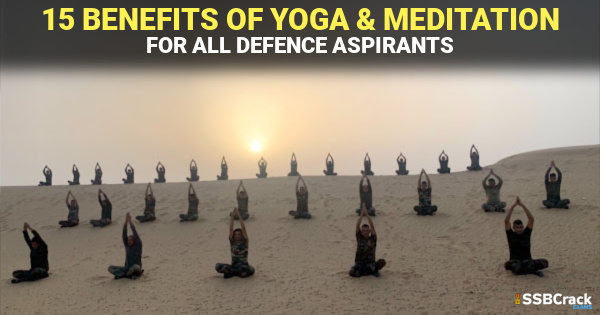Dear Warriors, Today we will discuss the benefits of yoga and meditation for all defence aspirants. As the world is celebrating the International Day of Yoga 2022, the importance of Yoga in day-to-day life has been discussed and the daily practice of yoga and meditation bolsters physical and mental health by providing harmony between the body & the mind. Physical fitness is not just important to the IO and GOR but also an important part of our personality as they are the visible signs of the amount of hard work we are putting in to achieve our dream of olive green.

Yoga and meditation typically go hand-in-hand and have been around for thousands of years. They’ve been used as an alternative form of exercise to keep the mind and body healthy and happy. Practicing yoga improves balance, endurance, flexibility, and strength, while meditation helps keep the mind sharp, relieves stress and anxiety, and can strengthen your immune system.
So what are the benefits of practising yoga? Put simply, the reason so many people are falling in love with yoga is that they are discovering how wonderful it is for your mind, body, and spirit for all aspirants. But in case you’re not yet convinced, we’ve come up with our top 15 reasons why yoga is incredible.



Also Read: Everything You Must Know About 15 OLQs And 4 Factors To Clear SSB Interview
- Yoga increases your flexibility. This is why many people start yoga, and it’s certainly a great benefit of yoga practice. Yoga postures and sequences help to increase the body’s range of motion. The mindful approach of yoga helps to ensure that stretching is done safely, allowing the nervous system to release the muscles into gentle, effective stretches. This reduces the risk of injuring ligaments and tendons, which can occur through more aggressive approaches to flexibility training. Releasing tension in the muscles can also help them to relax and let go, helping your body to open up more.
- Yoga helps you to build strength. Although many people overlook this one, seeing only yoga’s benefits for flexibility, yoga is actually a fantastic strengthening practice. Yoga helps to strengthen the muscles that support the body’s weight, leading to functional strength. It is also fantastic for building core strength. This improves athletic performance and your functionality in everyday life while keeping you safe from injury.
- Yoga improves your posture. One of the great things about the strengthening and stretching work of yoga is that it is a balancing practice. Yoga can help to address any muscular imbalances, lengthening tight areas and strengthening weak areas. Our posture can often deteriorate as we age, in a large part due to our habitual movement patterns during the day. For instance, if you spend a long time working at a computer, you may find yourself vulnerable to slumping with rounded shoulders. Over time the back muscles become weak, and the chest muscles become tight, exacerbating the rounded posture. Yoga can help you to stretch out the chest and strengthen the muscles of the back. It can also make you far more aware of your body and posture, so that you find yourself automatically self-correcting to come into a healthier alignment throughout the day.
- Yoga helps to keep your joints healthy. Yoga will strengthen the muscles around the joints, helping to stabilise them. By moving the joints in their full range of motion, yoga can help to promote better joint health. The mobilisation of the joints improves the flow of synovial fluid, which lubricates them, allowing for smooth and healthy movement of the bones. Synovial fluid also delivers fresh oxygen and nutrients to the joint cartilage, helping to restore it and keep it healthy. Yoga can even help those with more serious joint problems such as arthritis, improving physical function and reducing pain.
- Yoga is a powerful mindfulness practice. Yoga is about uniting the mind, body and breath. In doing this it brings you into the present moment. Mindfulness has proven benefits for a whole range of health conditions, and is particularly effective in promoting positive mental health. In particular, mindfulness practices have been shown to strengthen the immune system, improve social relationships and reduce depression, anxiety and neuroticism. The benefits of increased mindfulness through yoga clearly reach far beyond the mat.
- Yoga reduces stress. Many people begin yoga to improve their flexibility, but they keep coming back because they find it makes them feel so much better. The focus, centring and breathing of yoga all help to reduce stress and can be the ideal antidote to a hectic modern lifestyle. In part this is another wonderful benefit of the mindful aspect of yoga. It is also due to the positive impact of increasing activity levels and exercise, along with the relaxation and reduction of physical tension that yoga brings. Yoga can leave you feeling relaxed and refreshed, physically, mentally and energetically.
- Yoga lowers blood pressure. Having high blood pressure is a serious medical condition, which is associated with increased risk of both heart attacks and strokes. As well as reducing stress, which can be a contributing factor to high blood pressure, several aspects of yoga practice are thought to directly improve blood pressure. The relaxation and deep breathing of yoga can reduce high blood pressure even after the practice is finished. Certain postures such as Supported Bridge Pose, Legs Up The Wall Pose and of course Savasana or Corpse Pose are particularly beneficial for those with high blood pressure.
- Yoga helps you to make healthier life choices. There is a story in yoga about the student who asked their yoga teacher whether their smoking habit would interfere with their yoga. The teacher smiled and replied. “No, but your yoga will interfere with your smoking.” Whether or not that was the case, one of the great things about yoga is that it helps you to tune into what your body wants and needs. Many people find that the acceptance and self-love that they practise on the yoga mat can have a profound impact to the way they treat their bodies off the mat, whether that is through improved activity levels. better nutritional choices or reduced reliance on alcohol or tobacco.
- Yoga improves breathing. The basis of yogic breathing practices lie in pranayama, or yogic breathing techniques. These techniques, which are integrated into the vast majority of yoga classes, can be amazing for restoring balance and vitality to the body and mind. Controlled breathing can increase energy levels and relax the muscles, while reducing stress, anxiety and depression. On a physiological level, regular yoga practice has been found to improve lung capacity and breathing both in healthy adults and those who suffer from asthma.
- Yoga encourages your body’s natural healing process. The body has an incredible ability to heal itself, given the appropriate conditions. Yoga practice can be a wonderful way to create an environment which allows the body’s innate healing powers to kick in. In part this is due to the effects of mindfulness on the immune system, increasing the body’s ability to fight disease and restore health. The strengthening and lengthening effects of yoga can improve mobility and function, helping the body to recover from physical injury. And the benefits for mental health can lead to improved sleep patterns and enhanced wellbeing, greatly improving your quality of life.
- Yoga Improves Heart Health. Yoga is linked to a reduced risk of heart disease. When it comes to heart health, retirees need to be wary and maintain a healthy lifestyle as much as possible. Thanks to yoga and meditation, keeping your heart healthy is easy. Studies have shown that yoga is linked to a reduced risk of heart disease because of its cardiovascular benefits that eliminate arterial plaque. Meditation also helps lower heart rate and improve blood circulation. Meditating one time a day for ten minutes can help you relax, reduce stress hormones, lower your blood pressure, and allow for better blood flow.
- Yoga Improves Digestion. Many yoga poses massage internal organs and help your digestive system. If you have trouble with your daily fiber intake and can’t get things moving easily, practicing yoga can be a tremendous help. There are many yoga poses, twists, and moves that massage internal organs to help food move along in your digestive system. Yoga also stimulates the lymphatic system that helps flush out toxins, making your body overall cleaner. Meditation can also help with symptoms of Irritable Bowel Syndrome (IBS) and Irritable Bowel Disease (IBD) by reducing the frequency of stress-related flare-ups.
- Yoga Helps You Sleep Better. A senior man and woman sleeping peacefully. Meditation and breathing techniques also help clear your mind, allowing a good night’s sleep. In order to live a healthy, balanced lifestyle you need to get enough rest so you can function the next day. If you have trouble sleeping or suffer from insomnia, yoga can greatly improve your sleep quality. Doing yoga twice a week helped people sleep better, reduce stress, and lower anxiety. Meditation and breathing techniques also help clear your mind so you can relax and slow down your thoughts, allowing you the peace of mind to get a good night’s sleep.
- Yoga Boosts Your Mood. Practicing yoga in a group setting stimulates the production of oxytocin. Yoga and meditation have been linked with emotional health boosts. Studies have shown that yoga and meditation help improve cognitive-behavioral performance as well as aid with mood swings, menopause, schizophrenia, insomnia, depression, and anxiety. Practicing yoga in a group setting also stimulates the production of oxytocin, otherwise known as the love hormone, and it also produces more serotonin–the happy hormone. Combined, these hormones can dramatically improve someone’s mood.
- Yoga Provides Mental Clarity. Simple yoga practices and breathing techniques allow you to free your mind from “clutter.” A healthy dose of yoga and meditation will keep your brain sharp and clear. Simple yoga practices and breathing techniques allow you to free your mind from the “clutter” that trickles down to your physical wellbeing. Slow breathing and yoga poses will help your memory and keep your thoughts more organized once you lessen your stress, anxiety, and negative thinking. Reaching a place of quiet peacefulness is the key to healthy memory function.
Following a few simple poses, breathing techniques, and positive coping skills can help retirees manage stress, improve mental clarity, manage chronic conditions, and promote a healthier lifestyle. With so many health benefits linked to these traditional practices, many retirees are taking notice and incorporating these techniques into their lifestyles.
Please don’t just take our word for it though. Get yourself out there, get on your mat, and experience for yourself the incredible benefits of yoga practice. Jai Hind.
Also Check: 10 Tips To Remain Physically Fit For All The Defence Aspirants
To crack the SSB interview, You can join our SSB interview live classes batch and we recommend you to Enroll SSB INTERVIEW ONLINE COURSE. Trusted by thousands of defence aspirants.



















